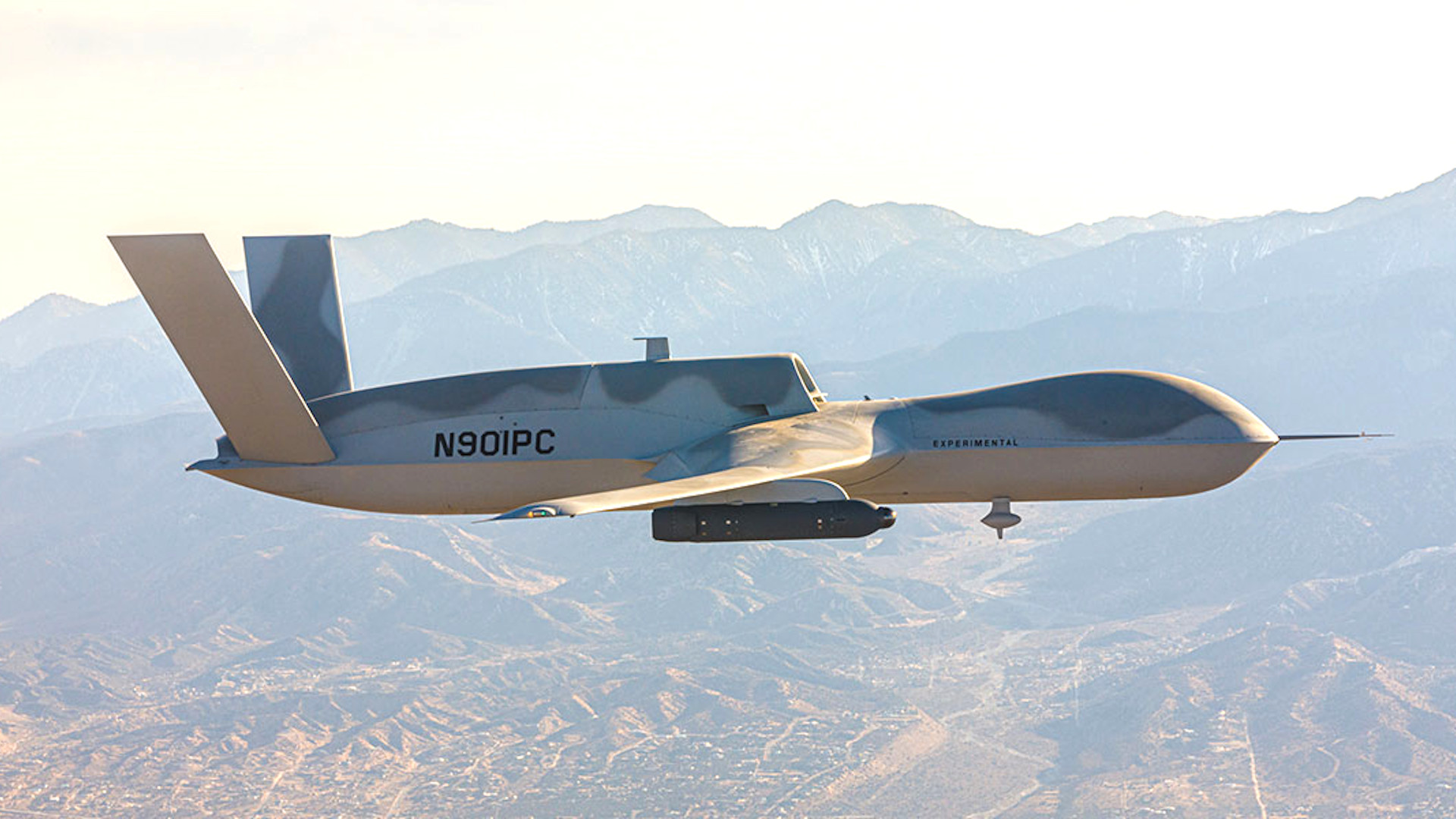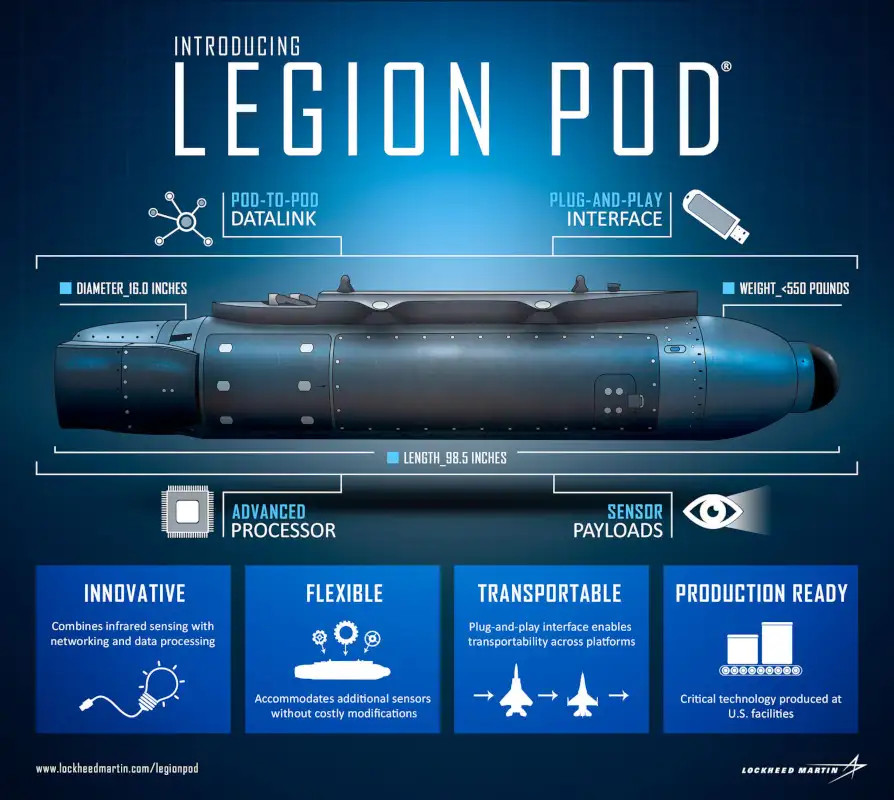General Atomics has conducted a flight test involving one of its stealthy Avenger unmanned aircraft carrying a Lockheed Martin Legion Pod under its wing. The Legion Pod is fitted with an infrared search and track sensor, or IRST, designed to detect and track other aircraft at extended ranges, but can also be configured to carry various other sensors and systems. This combination could quickly give Avengers an array of new capabilities for use when acting as a “loyal wingman” together with manned aircraft or flying autonomously, alone or together with other unmanned platforms.
General Atomics’ Aeronautical Systems division, or GS-ASI, announced the flight test on Jan. 15, 2021, but did not say specifically where or when it occurred. The flight lasted 90 minutes and was a captive carry test intended to make sure the Avenger could safely carry the pod on the underwing pylon. GA-ASI said that it had taken less than three months working in cooperation with Lockheed Martin “to move from concept to flight.”

“Our flight demonstration revealed the quick reaction capabilities of the Avenger RPA [remotely piloted aircraft],” GA-ASI Vice President of Strategic Development J.R. Reid said in a press release. “From software and hardware architecture implementation to sensor integration, the Avenger is a great platform for delivering critical capabilities.”
“The successful integration of Legion Pod on the Avenger RPA is a testament to the flexibility of the Legion Pod system from a fighter aircraft to an unmanned aircraft, which means Legion Pod has proven its capabilities can assist our warfighter and keep them ahead of threats,” Kenen Nelson, director of Fixed Wing Sensor Programs at Lockheed Martin’s Missiles and Fire Control, said in the same statement. “We are excited to see how our IRST21 systems will be integrated on other unmanned platforms.”
It’s also not clear if integrating the Legion Pod onto the Avenger has been an independent initiative on the part of the two companies or if this is in response to specific requirements from a particular customer. On Jan. 6, GA-ASI had also announced that the Air Force had hired it to modify two Avengers as surrogates for the Skyborg program.
This pair of drones are set to receive “upgraded datalinks and the core Skyborg System Design Agent (SDA) software, as well as other payloads,” as part of that project, according to General Atomics. “These Avengers will then be used as part of various experimentation events in 2021 and 2022, which will enable manned aircraft to control Avengers while in flight and relay specific information between the manned and unmanned aircraft,” a press release at the time added.
The Air Force Research Laboratory is leading the Skyborg project, which is seeking to develop a suite of artificial intelligence (AI) driven systems that will be able to control “loyal wingman” type drones, as well as potentially fully-autonomous unmanned combat air vehicles (UCAV). You can read more about the Skyborg program and its goals in this past War Zone piece.
In December 2020, GA-ASI, as well as Boeing and Kratos, had received a separate contract to develop new prototype loyal wingman drones to carry the Skyborg systems. More than a dozen companies, in total, are supplying various other components for the project. A video presentation, seen below, on Skyborg that Air Force released last year included a notional drone design that appeared to have an IRST sensor in its nose.

Also in December 2020, the company announced it had conducted a test flight involving an Avenger carrying a software package originally developed by the Defense Advanced Research Projects Agency and that is now maintained by the U.S. Navy. That test saw the drone fly semi-autonomously in coordination with five other simulated Avengers to conduct a mock air-to-air mission in which they searched for aerial threats.
The Avenger, which has an internal weapons bay that could potentially be configured to fire air-to-air weapons, would be particularly well suited to that kind of mission when also equipped with the Legion Pod. With data links installed in the pod, it could potentially push information about any potential threats it detects straight to other manned or unmanned aircraft. The IRST21 sensor is capable of providing actual targeting information, which could also be transmitted to those offboard platforms. Multiple IRST21 carrying aircraft could improve that targeting through triangulation, a perfect job for loyal wingmen and autonomous drones.
Unlike radars, IRST sensors work passively, meaning hostile aircraft being tracked may not even know they’ve been detected. They similarly do not give away the presence and potential location of the aircraft carrying them. Beyond that, they provide a valuable alternative to radar when attempting to spot aerial threats in environments where there is heavy electronic warfare jamming and are unaffected by radar-evading features on stealthy aircraft or missiles.
As already noted, the Legion Pod is also designed to modular and has an open-architecture design intended to allow for the rapid integration of new payloads and functionality in the future. You can read more about this pod, in general, in this past War Zone piece.

All told, the addition of the Legion Pod on the Avenger could open very exciting new doors for that particular unmanned aircraft and for the Legion Pod itself. It also offers new insight into the kind of capabilities that the Air Force might be looking as part of the Skyborg program.
Just the idea of stealthy, networked drones carrying IRSTs represents a palpable threat to the world’s most advanced and stealthy enemy aircraft.
Contact the author: joe@thedrive.com
